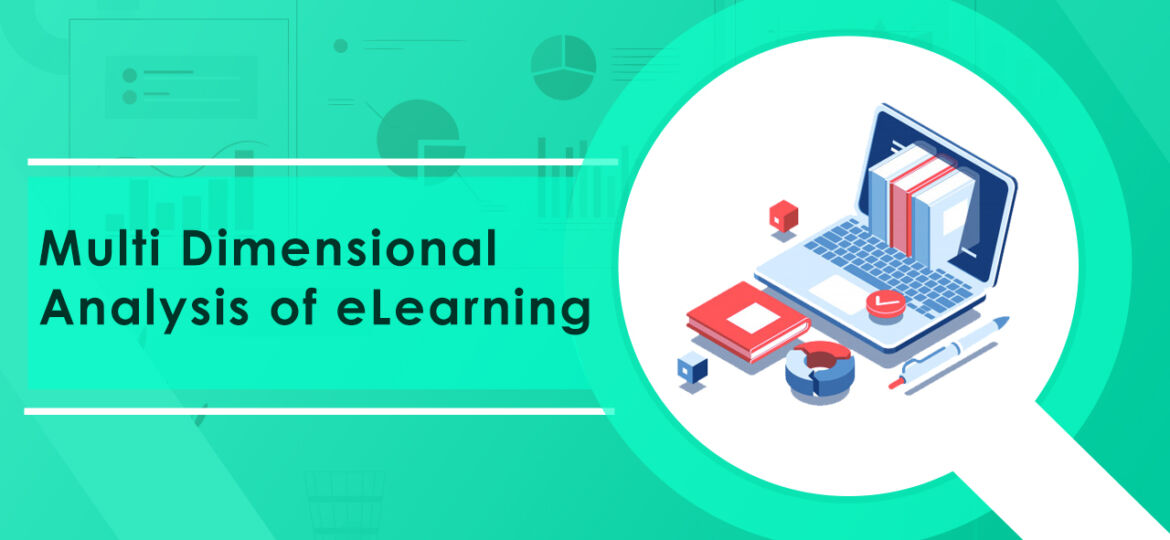
Analysis Of eLearning
Each of these possibilities might as well be a mantra for success or a recipe for disaster. Here’s the tricky part: you never know what works unless you try it. And in this case, the only way to proceed forward is by a rigorous and thorough analysis of each of the possibilities available at our disposal.
When we consider eLearning as a project of countless positive outcomes, it becomes all the more mandatory to brainstorm and analyze each of those productive results so that we can determine which outcome/business model best suits our interests and that of the client base simultaneously.
There are numerous aspects of analysis involved in a project. However, eLearning is unlike any other project.
It involves skill as well as the swift application of understanding for a smooth transfer of useful information from one person to another; therefore, the forms of analysis we need to employ in such a cumbersome project need to be meticulous and precise enough for us to be successful in our goals involving eLearning.
Let’s delve further into the various perspectives of analysis that are employed when taking eLearning into our scope of focus.
1. Task Analysis
Every form of a project, including eLearning, focuses on the effectiveness of teamwork and team spirit. Such is the importance that it is necessary to specify the job roles and divide tasks efficiently as per the strength of individual team members such that productivity is ensured while keeping the amount of effort exerted by the team at a consistent level.
This type of analysis is vital for defining job descriptions, the priority level of tasks, the deadlines involved, etc. This analysis is based on information collected from the following activities:
- Discussion with team members
- Assessment of individuals in the team as per assigned activities
- Discussion with team leaders
- Extensive research about a particular subject of interest
2. Technical Requirement Analysis
eLearning is an interactive form of learning based upon the technology that can harness it. Components of this learning involve the technical/hardware requirements for accessing the courses as well as the software that will support the online courses.
Technical requirement analysis takes a walk through the understanding of what types of technicalities, for example, internet connectivity, media specifications, operating systems, etc., are required for the smooth functioning of eLearning modules.
3. Objective Analysis
eLearning, like any other venture, has some primary objectives that signify the overall effectiveness of the process of information and knowledge transfer. Objective analysis aims to analyze whether the desired objectives are being met or not. On the basis of such analysis, a decision is then taken to bridge the gap between the desired output and actual output.
This further leads to identifying the requisite knowledge and skills that are essential to meeting the goals and needs that the eLearning module needs to fulfill and application of such skills for the improvement of output.
The data for such analysis may be obtained by discussions with the targeted audience base, review of organizational documents (visions, principles, mission), close monitoring of the response of targeted audience base to the applied eLearning module, etc.
4. Content Analysis
Goals and objectives are of the utmost importance in the case of eLearning modules. More often than not, the presence of redundant and excessive, irrelevant information leads to unnecessary jargon which leads to a reduction in the efficiency of a course.
Content analysis aims to look into instructions and steps that are to be incorporated into the eLearning modules and courses so that the goals can be met satisfactorily. This also helps weed out irrelevant material present in the courses. Basically, this analysis involves refining the content material of the eLearning module to increase its understanding and clarity.
5. Learning Environment Analysis
Learning is a creative activity that requires concentration of the highest level. Therefore, the environment in which the audience is going through the eLearning module is a potential catalyst in facilitating a better understanding of the online course.
This form of analysis aims to understand the medium (such as employees connecting over webcast simultaneously, collective listening to radio discourse, etc) through which the course can be undertaken.
6. Audience Base Analysis
The validity of an eLearning course is set up by the audience base interested in it. This audience may be of a particular age group or generally based on the content. Hence, the analysis of the target audience is crucial in developing the eContent so that the course is well received among the audience.
The understanding arising from the analysis helps to curate the eLearning module as conducive to the appropriate audience for the faster and qualitative discourse of information.
The various types of analysis, as mentioned above, are critical to rejuvenating the eLearning module creation process for good. This eventually leads to better quality content and more efficient learning among the targeted audience.
